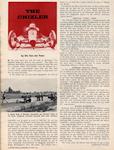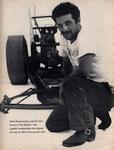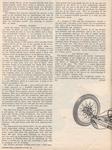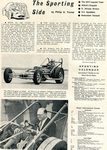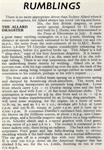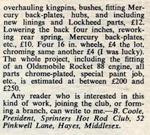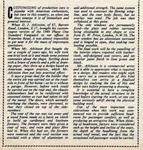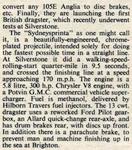
As told exclusively to 1950s... Several things happened in the 1950s to kick start Drag Racing in the UK. Hot Rod magazine was available in shops along with other American titles all with bright, colourful covers showcasing these wild looking cars that stood out among the mostly black and white publications. This must have inspired a few potential Hot Rodders and indeed a few Hot Rod clubs were popping up throughout the UK in the 1950s but nothing was happening on a national scale just yet.
The American sport of Stock Car Racing was introduced into the UK in 1954, racing around quarter mile ovals and drawing huge crowds. The following year a team of seven American drivers and their cars came over to the UK to show the British how it was done. Much like the Drag Festivals would do for Drag Racing nine years later. The American Stock Cars were all ‘30s Ford coupes, and just like the Hot Rods seen in the American magazines, they were fitted with later Mercury 24-stud flatheads, bored and stroked, with all the latest speed equipment including triple carbs and aluminium heads. They also had hydraulic brakes, offset wheels, lowered suspension and Halibrand quick-change rear ends whereas the British drivers were running their cars much the same as how they’d pulled them from the scrapyards with stock engines and suspension. But the British were taking note and the American visit helped boost the sport of Stock Car Racing in the UK.
1960... One interested spectator at the oval tracks was Ken Cooper who was already hooked on all things American, especially the cars and the V8 engines. He had a bright yellow ‘37 Ford coupe that he ran on the street and had swapped the 21-stud flathead for a 24-stud Mercury mill with dual exhausts and motorcycle mufflers. He’d also lowered the front suspension but, unlike the roundy-round Stock Car Racers, had raised the rear end and fitted bigger tyres making it look more like a Hot Rod that was setup to run at the Drags.
Ken had discovered Drag Racing in the American magazines and was particularly interested in the crude slingshot Dragsters; he couldn’t believe they could accelerate to 120mph in a quarter mile. He’d built up a collection of early Ford parts while modifying his Ford coupe and realised he had enough bits to build an American Dragster. A lot of the Dragsters in the magazines were using Ford flathead engines, gearboxes and axles; all that he needed was some tube and he’d have all the ingredients. Having got the necessary tubing Ken and his mate Mike Turner put the engine, gearbox, axles and wheels together, then welded up the tubing making a slingshot chassis. They thought, this is good, but where the hell would we run it? There was no drag racing in the UK in 1960. Little did they know that at the same time, the proprietor of the Allard Motor Company, Sydney Allard was having the same idea but on a somewhat grander scale. Sydney had also been thumbing through the American Hot Rod magazines and found instant inspiration after reading that Chris Karamesines in his Chizler Dragster had just clocked 200mph in the standing start quarter mile, something automotive journalist Roger Huntington had said was impossible. Sydney came into work one day slamming the magazine down on the desk saying ‘We’re gonna build one of these!’ In February 1960 a Hot Rod Club known as the Sprinters, later renamed the Highwaymen, from the Uxbridge area wrote letters to many of the motoring magazines telling of the club and its aims and hopes of promoting organised Drag Racing and Hot Rodding in Britain. Eventually a mention was published in the September Car Mechanics Magazine in Tony Bostock's monthly Hot Rod column. This was seen by a nearby club, the Road Knights from Maidenhead and soon a joint meeting was held resulting in the birth of the British Hot Rod Association on September 1st 1960. Early members included Brian Coole who was building a ‘34 Ford Hot Rod, also Allan Herridge and Brian Witty who were both planning to build American style Dragsters and Peter Bartlett.
An American Hot Rodder Lee Siebenthaler along with Brian Coole laid the groundwork for the BHRA which aimed to promote and sponsor quarter mile Drag Racing competition, Custom Car Shows and other Hot Rodding activities. They were later joined by Vic Outen who began the long and laborious task of educating the British public about the excitement Drag Racing and Hot Rodding offered with countless letters to the motoring press. Another early member was Ken Cooper who also had his own local club in Birmingham called the Roadrunners, and Clive Lingard from Manchester who was rodding a Model Y Ford along with his club the Dragons. Also, from Southampton there was John Baker and the Vikings Hot Rod Club, and from Romford a young Mike Titterton who’d started another club known as the Sprinters. 1961... January 1961 saw the start of the Allard Dragster build. Sydney’s objectives were to create an indigenous audience for a phenomenon so far not seen in the UK, to encourage the construction of similar cars and to reinforce the American Drag Racing fraternity's case for FIA recognition of the standing start quarter mile as an international and world record distance. Allard’s chief designer Dave Hooper designed it under Sydney’s supervision and development engineer John Hume built it in Allard’s Clapham workshop under Sydney’s office. The October 1960 issue of Sports Cars Illustrated featured a very useful description and cut away drawing by Gordon Bruce of the Chizler Dragster which the Allard Dragster was loosely based on. The RAC build regulations did not recognise Dragsters and would class it as a racing car meaning the engine needed a cover and front brakes were necessary. They also wanted to see rear suspension on the car. Sydney was happy to comply with the front brakes and engine cover but wasn’t about to fit rear suspension and after a few meetings with the RAC they dropped this requirement.
Meanwhile in Birmingham, Ken Cooper wasn’t at all happy with the RAC regulations when he got to hear about them. He was building a Dragster just like the ones in the American magazines and he wasn’t going to compromise so he dismantled it, dragged the chassis down to the bottom of the garden where it stayed until 1964. He decided instead to use the bits to build another Hot Rod based on a ‘33 Ford Cabriolet. The Allard Dragster was completed in just 23 weeks and ready for testing by June ‘61. They’d fitted a 354 Chrysler hemi and added a 6-71 GMC supercharger and Hilborn injection but because of the engine cover requirement couldn’t fit it on top of the engine, so used a Potvin setup mounting it low down in front of the engine which would then be covered with aluminium body panels. Gearbox was a Ford V8 3-speed with an 11-inch Schiefer double disc clutch. Only second and top gears were used and the rear axle was also Ford V8 fitted with a quick-change giving a range of ratios from 2.8 to 4.0. First appearance was at Brands Hatch in July without the body as a static exhibit at a Shorrock Supercharger demonstration. Then on Monday July 24th it was shown officially to the motoring press and made some noise at Silverstone, still naked, maybe the RAC weren’t looking! TV cameras from ITN were also there. Unfortunately, Sydney had already burnt out two expensive Schiefer clutches during private testing. They didn’t have a replacement so a stock Ford clutch had been temporarily fitted. They later tried a 7½-inch Borg and Beck 5-plate clutch originally developed for the 600bhp V16 BRM which seemed to do the job.
The plan was to do walking-speed rolling starts initially to save the clutch, clocking a best of 9.5 seconds at an estimated 150 –170mph. Next a standing start was tried using top gear only producing a 12 second run. They then went for a second gear standing start but the V8 Ford Pilot gearbox had had enough and gave up the ghost. After Silverstone the bodywork and a triple parachute were fitted as the Dragster was readied for the Brighton Speed Trials on Saturday 2nd September where Sydney planned to attack the standing kilometre record at 23.21 seconds.
The sun was shining at Brighton, and the crowds gathered round the Allard Dragster which looked amazing with its beautiful swoopy full bodywork resplendent in a Gerry Belton designed metallic blue and white paint job, chromed front axle, suspension and steering arms, with four long chromed exhausts protruding either side of the big blown ‘n’ injected Chrysler hemi. British racing fans were not used to seeing such attention to detail on a race car and chromed underpinnings were unheard of, but that was the American way. It was brought to the line for its first run, but a fuel blow-back fractured a fuel line and the Allard Dragster spluttered down the kilo in 37.91 seconds. Repairs were made and out it came again but this time it was misfiring badly and stalled on the line. This was later found to be due to the Scintilla magneto which had been moved by the fuel blow-back putting out the timing. Nevertheless, for sheer noise value the spectators loved it, including Ken Cooper who had driven down from Birmingham in his ‘37 Ford yella coupe.
Despite a disappointing public debut at Brighton the Allard Dragster had created a lot of interest and was soon back out at Wellesbourne Records day on October 14th where Sydney ran a fantastic 10.841 seconds over the quarter to the relief of the Allard Team, showing the true potential of the car. This meeting was run by the National Sprint Association. The NSA had been formed in 1958 at a time when sprinting in the UK was beginning to make a comeback and they were instrumental in helping the rebirth of the sport with their monthly magazine, The Sprinter, and by putting on Sprints and Records Meets throughout the UK. Magazine articles: click thumbnail to enlarge, click back to return. Gallery: click on any thumbnail for a large image.
Back to pioneers index Back to News page |





































